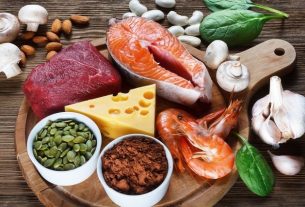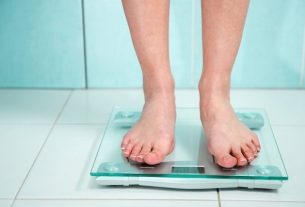The points diet is a diet that mainly considers the calories in food, where each person can consume a certain number of points during the day.
This diet is a tool that can help with weight loss, because the calculation of the points allowed per day is always done according to each person’s caloric expenditure, which allows the calories in the diet to be reduced.
Created by endocrinologist Alfredo Halpern, this diet must be followed by writing down all the foods and the quantities consumed during the day, which can also help in choosing healthier foods, which normally have fewer points.

How to do the points diet
To follow this diet, you must calculate the number of points allowed throughout the day according to your daily caloric expenditure and desired weight loss.
Diet points are distributed according to the calories in the food. These points must be recorded daily in a diary, or notebook, to help control the total points consumed.
In this diet, all foods are allowed, and care must be taken not to exceed the total number of points allowed per day.
Step 1: calculation of caloric expenditure
Daily caloric expenditure can be calculated by multiplying the basal energy expenditure, or basal metabolic rate, which is the amount of energy the body uses to maintain basic functions, by the activity factor, which considers the energy spent on activities such as cleaning the home, work and physical activities. Learn more about basal metabolic rate.
To calculate your calorie expenditure, enter your data into the calculator below:
Step 2: calculation of points
After figuring out your caloric expenditure, you need to calculate the recommended points for losing weight. To do this, you must divide the total calories by 3.6, where each 3.6 calories are equivalent to 1 point. Therefore, to lose weight, it is recommended to reduce between 200 and 300 points from the total obtained.
Example: A 40-year-old woman weighing 60 kg and practicing physical activity for 3 hours a week has a caloric expenditure of 2205 calories.
Thus, you must divide 2205 calories by 3.6 = 612 points. To lose weight, this woman needs to reduce 200 points from this total, leaving 612 – 200 = 412 points, for example.
Points Diet Table
The points diet table indicates the score for each food, which must be added throughout the day until reaching the total points consumed.
This table should always be consulted and includes food groups that can be consumed as much as you want and others that must be accounted for according to each portion.
Group 1- Released foods
The foods released are those that are low in calories and, therefore, can be consumed at will.
Thus, the foods released from group 1 are:
- Vegetables: chard, watercress, celery, lettuce, seaweed, chicory, pigweed, chicory, cabbage, Brussels sprouts, fennel, endive, spinach, beetroot leaves, jilo, gherkins, turnips, cucumbers, peppers, radishes, cabbage , arugula, celery, taioba and tomato;
- Spices: salt, lemon, garlic, vinegar, green scent, pepper, bay leaves, mint, cinnamon, cumin, nutmeg, curry, tarragon, rosemary, ginger and horseradish;
- Low calorie drinks: coffee, teas and lemon juice without sugar or sweetened with sweeteners, diet soft drinks and water.
Vegetables in this group can be used to increase the volume of meals and provide more satiety, as they are rich in fiber.
Group 2 – Vegetables
Every 2 tablespoons of vegetables in this group count 10 points in the diet and include:
- Pumpkin;
- Zucchini;
- Eggplant;
- Beet;
- Onion;
- Carrot;
- Cauliflower;
- Okra.
In addition, 2 tablespoons of artichokes, asparagus, broccoli, chayote, fresh peas, palm hearts, and green beans, mushrooms, bamboo shoots, bean sprouts or chives are also equivalent to 10 points each.
Group 3 – Meat and eggs
Each portion of this group is worth an average of 25 points:
100g of rump, filet Mignon, beef sirloin and pork chop are equivalent to 40, 70 and 78 points, respectively.
Group 4 – Milk, cheeses and fats
This group includes dairy products, oils and olive oils, and their scores vary as shown in the following table:
Although not considered a dairy product, the soy vegetable drink is also part of this group, where each 100 ml is equivalent to 15 points.
Group 5 – Cereals and legumes
Each serving in this group is worth an average of 25 points and includes foods such as rice, pasta, beans, oats, bread and tapioca:
In addition, 1 tablespoon of brown rice, 1 tablespoon of cornmeal, 1 small piece of cassava and 1 tablespoon of mashed potatoes also equal 20 points each.
Group 6 – Fruits
The following table shows the portion of fruit equivalent to 11 points:
In addition, every 10 large units of strawberry, 1 kiwi or 1 small unit of persimmon also equal 11 points.
Drinks
Drink points vary depending on the type and quantity of each one:
Alcoholic drinks, such as 1 glass of wine and 1 dose of 50 ml of whiskey, gin or vodka, correspond to 50 and 45 points, respectively.
Candy
Just like drinks, the points in this group vary depending on the type and quantity of each one:
In addition, 1 fruit popsicle, 1 dessert spoon of jelly and 1 tablespoon of brown sugar are equivalent to 18, 12 and 20 points respectively.
Benefits of the points diet
The main benefits of the points diet are losing weight, maintaining a flexible diet, but without restricting the foods you like or prefer.
Possible disadvantages
The main disadvantage of the points diet is that it aims to control only the quantity and not the quality of the food consumed, which can favor nutrient deficiencies in some people.
Furthermore, during this diet there is no nutritional re-education process that encourages the choice of healthy foods. Thus, after finishing the diet, people who have bad eating habits can regain the lost weight. See how to carry out dietary re-education.

Sign up for our newsletter and stay up to date with exclusive news
that can transform your routine!
Warning: Undefined array key "title" in /home/storelat/public_html/wp-content/plugins/link-whisper-premium/templates/frontend/related-posts.php on line 12
Warning: Undefined array key "title_tag" in /home/storelat/public_html/wp-content/plugins/link-whisper-premium/templates/frontend/related-posts.php on line 13



